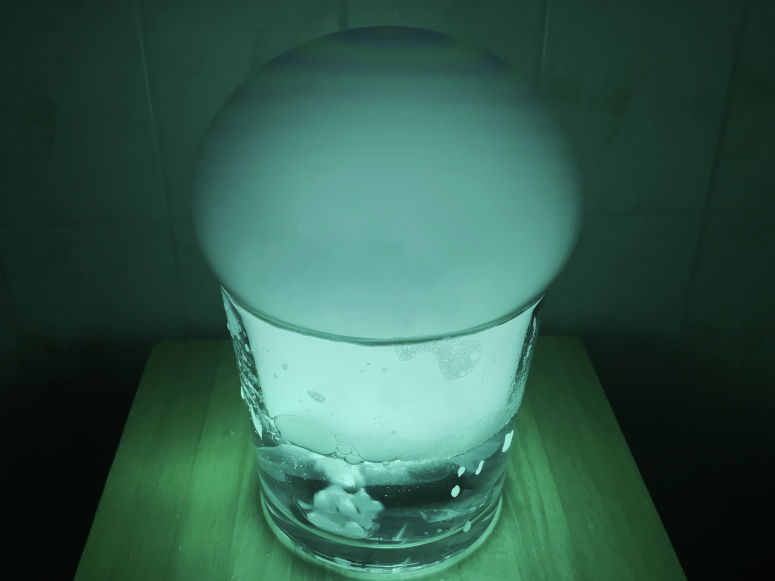Fun and easy science experiments for kids and adults.
Chemistry
Place dry ice (solid carbon dioxide) in a bowl of water and watch it bubble away. Then trap the gas in a giant soap bubble. This is an experiment about states of matter.
| Gilla: | Dela: | |
Video

Materials
- Dry ice - About 1 dl (1/2 cup) is needed for this experiment. Either block or pellets.
- If you buy a block:
- 1 towel
- 1 hammer (or something else to break the ice)
- 1 large and round bowl
- 1 cup (or something similar)
- 1 strip of fabric (for example a shoelace or a strip of sheet)
- Dawn (or Fairy) dish soap
- Glycerin
- Water
- Safety equipment: 1 glove or 1 pair of tongs
Warning!
These risks exist:- The freezing point of carbon dioxide is -78.5 °C (-109.3 °F), but carbon dioxide ice can be much colder than that. There is a risk of frostbite on contact with the skin. However, touching smoke or bubbles formed with the help of carbon dioxide is safe.
- Carbon dioxide sublimates (changes from solid form to gaseous form) in everyday temperatures, which results in a large amount of carbon dioxide gas that can push the air away. There is a risk of drowsiness, headache or, in the worst case scenario, unconsciousness or suffocation. However, if you only use one block of carbon dioxide and have normal ventilation, you don't need to worry.
- Never put dry ice in a closed container. There is a risk of explosion when the ice sublimates.
- Do not touch dry ice with bare hands.
- Make sure to have very good ventilation.
- Practice what to do if someone is injured by dry ice:
- Inhalation: Move to fresh air. Rest. Get medical attention if necessary.
- Skin contact: In case of frostbite, flush with water for at least 15 minutes. Use sterile bandage. Get medical attention.
- Eye contact: In case of frostbite, flush with water for at least 15 minutes. Use sterile bandage. Get medical attention.
- Ingestion: Get medical attention.
Step 1


Step 2 (if you've bought a block)


Step 3


Step 4


Step 5


Step 6


Step 7


Step 8


Short explanation
Carbon dioxide sublimates at room temperature. That is, changes from solid to gas. This happens faster in warm water, and lots of bubbles of carbon dioxide gas are formed. Here you capture the gas in a large soap bubble. The carbon dioxide gas is extremely cold and cools the air. This causes water vapor in the air to condensate, that is change from gas to liquid, and become visible as smoke.Long explanation
Every pure substance can exist in different forms, each with distinct properties. These different forms are called states of matter. In everyday life, the three states of matter that are commonly observed are solid, liquid and gas. Then there are a few more that exist at extremely high or low temperatures, such as plasma, Bose-Einstein condensate, and quark-gluon plasma. In a solid state, the pure substance's particles (atoms, ions or molecules) are tightly packed and stuck together. In a liquid state, they are still close together, but can move relative to each other. In a gaseous state, they have completely separated from each other. The factors determining the state of a pure substance is pressure and temperature. At high pressure and/or low temperature, a pure substance is solid. At low pressure and/or high temperature, a pure substance is a gas. In between, the pure substance is a liquid. There are words for when a substance changes from one state of matter to another:- Melting: solid → liquid
- Sublimation: solid → gas
- Vaporization: liquid → gas
- Condensation: gas → liquid
- Deposition: gas → solid
- Freezing: liquid → solid
Experiment
You can turn this demonstration into an experiment. This will make it a better science project. To do that, try answering one of the following questions. The answer to the question will be your hypothesis. Then test the hypothesis by doing the experiment.- What if you use more dry ice?
- What if you use cold water?
- What if you use boiling hot water?
- What if you don't use glycerin in the soap bubble mixture?
- What if you use a bigger bowl?
- What if you use a small glass instead of a bowl?
- What if you place some lit tealights around the bowl?
Variations


| Gilla: | Dela: | |
Similar
Latest
Content of website
© The Experiment Archive. Fun and easy science experiments for kids and adults. In biology, chemistry, physics, earth science, astronomy, technology, fire, air and water. To do in preschool, school, after school and at home. Also science fair projects and a teacher's guide.
To the top
© The Experiment Archive. Fun and easy science experiments for kids and adults. In biology, chemistry, physics, earth science, astronomy, technology, fire, air and water. To do in preschool, school, after school and at home. Also science fair projects and a teacher's guide.
To the top

































































































































